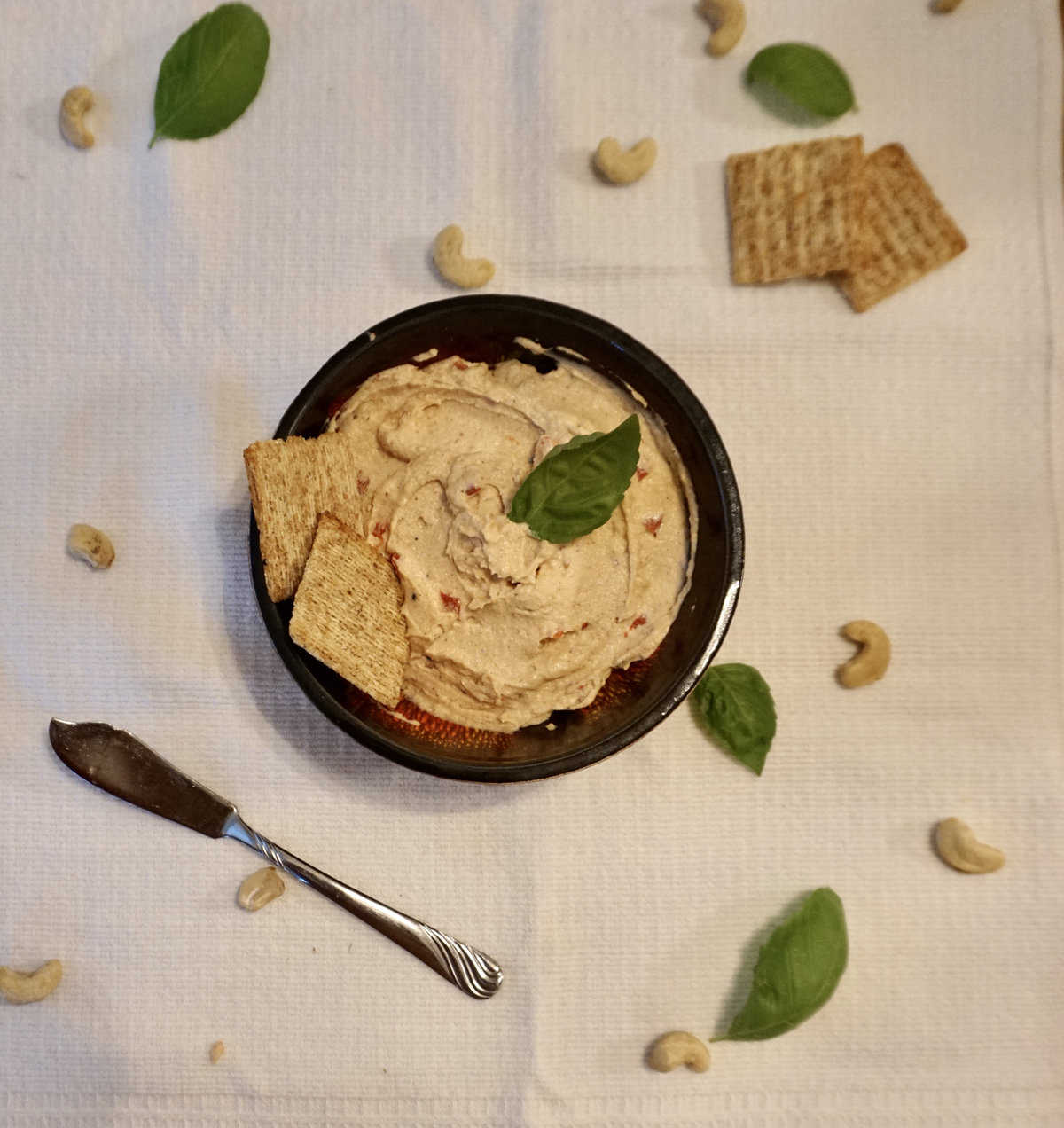How to Make Vegan Pimento Cheese Spread
Looking for a crowd-pleasing yet more sustainable addition to your charcuterie board? Please scroll down to see my recipe for cashew-based vegan pimento cheese spread. Not only is it a satisfying addition to a cheese plate, but it’s also a delightful way to introduce sustainability into snacking.
One thing that I enjoy about this vegan pimento cheese spread is that you can make it in five minutes or thirty minutes, depending on if you account for any preparation time.
What’s in this recipe?
Cashew Cream
There are plenty of good recipes for cashew cream, but I personally use the cashew cream recipe from Rainbow Plant Life. Generally, you want to have soaked cashews blended together with salt and nutritional yeast. We’ll walk you through how to make this in the recipe described below.
Nutritional Yeast
Nutritional yeast looks like tiny yellow flakes that provide a lot of dairy nutritional yeast looks like tiny yellow flakes that provide a lot of dairy notes. The yeast is deactivated and provides some protein and small amounts of B vitamins. Most recipes do not offer adequate nutrition with nutritional yeast since it’s used in small quantities, but it adds a nice flavor that helps satisfy your craving for cheese and dairy.
Lemons or lemon juice
Lemons and lemon juice serves to add a pop of flavor and a balance with acid. You can use store-bought lemon juice, but fresh lemon juice will give a brighter taste.
Pimento peppers
You’ve probably seen these peppers stuffed into olives in the past. Pimento peppers are a large, sweet red pepper that grows in the shape of a heart. Pimentos are sweeter than red bell peppers and are often seen diced. You will generally find them near the jarred roasted red peppers and olives in the supermarket.
Paprika
You can use either hot paprika or sweet paprika in this recipe, depending on your audience. I personally use sweet paprika to appeal to a larger crowd.
Salt & Pepper
Essential to any and every recipe.

Sustaining You and The Planet
It is widely accepted that animal agriculture is responsible for a large percentage of Green House Gas emissions. While many people make this association with meats, the dairy industry is also a contributor. Cheese contributes to more greenhouse gas emissions than chicken, fish, or pork and is the third-largest contributor to land use per kg. While cheese is a personal favorite, this vegan pimento cheese spread is a great substitute that will satisfy your cheese craving and reduce the abundance of resources needed to produce it.
Apart from its environmental impact, cheese is high in saturated fats, which contributes to artery blockages. While dietary cholesterol and blood cholesterol are not strongly correlated, there is strong evidence that an increase in saturated fats can raise LDL cholesterol levels, which is the kind that increased your risk for heart disease and stroke.
Food science tip:
You’ll need to start by soaking the raw cashews in water. If you’re in a pinch for time, you can pour boiling water over the cashews and let them soak for anywhere from 15-30 minutes or until the cashews are soft. But, if you’re any type of immunocompromised, I highly recommend this method as a pasteurization step.
However, if you’re a planner, you can soak these raw cashews in room temperature water either overnight or during the workday to save you some time. You should note that if you leave the cashews soaking for more than 12 hours, they may begin to ferment. If a raw diet is your thing, this fermentation actually adds a unique flavor to your cheese spread.

Vegan Pimento Cheese Spread Recipe:
Prep Time: 30 minutes Cook Time: 5 Minutes
Yields: 4 servings
- 1 cup cashews, raw
- 1 lemon, or 3 tbsp of lemon juice
- 2 oz of pimento peppers
- 1 tbsp nutritional yeast
- 1 tsp paprika
- Salt & Pepper to Taste

Recipe How to:
Part 1: Cashew Cream
- Soak your raw cashews in water for about 8 hours or with boiling water for 15-20 minutes, or until soft
- Drain your cashews, and place into a blender (You can use an immersion blender here, but a high powered blender like a Vitamix works great)
- Add nutritional yeast, lemon juice, and salt
- Blend until smooth and creamy
- Store Refrigerated
Part 2:
- In a bowl or container, add your cashew cream, pimentos, and spices
- With a rubber spatula or spoon, blend together until evenly dispersed
Serve with toasted bread, crackers, or vegetables for a delicious snack!

Final Thoughts
I have shared this recipe with a few friends and received great compliments. The key to vegan cheese spread recipes is not comparing it to a cheese product, but a stand-in replacement for a softer cheese. Of course, it will never be the same, but it does hit the spot for a cheese replacement and it deserves its rightful spot on a charcuterie board. Feel free to explore our other content, such as “Four Ways to Eat a More Sustainable Diet” or our “Healthy and Simple Lemon Asparagus Pasta”.
Thanks for stopping by to read our post!
Hope you enjoyed the post! Check out more on our homepage, and feel free to send to a friend. Let me know in the comment section if you test it out yourself!
Let us know if you like this article by leaving a comment below or tagging us on Instagram, Facebook, and Pinterest using @madetosustain! Please sign up for our mailing list for more content related to this and come back for more recipes and ideas for a more sustainable lifestyle.
Latest from the Blog
The Best and Worst Plant Based Diet Documentaries [2024]
Over the years, plenty of plant based diet documentaries have come out across streaming platforms. Some good ones really explain the benefits of a vegan diet and its impact on chronic diseases, and some discuss the impacts of animal agriculture on climate change. While some other documentaries are just nonsensical. Documentaries can be a powerful…
Seasonal Produce Guide: Fruits and Vegetables by Seasonality
Walk into any grocery store, and you’ll see more produce variety than you would have seen twenty years ago. Modern food supply chains deceive us into believing that our favorite produce is available all year round. But the truth is, these fruits and vegetables are delivered worldwide to meet the consumer demand for year-round fresh…
The Best Non-Toxic & Eco-Friendly Food Storage Containers
Meal Prep Videos always seem to go viral. But between purchasing plastic containers in bulk, the toxicity of plastics, and the expensive aesthetic containers, one common thread seems to be missing. How can you meal prep with eco-friendly containers? And which are the best non-toxic food storage containers? If you’re meal prepping, it’s inevitable you’ll…
Discover more from made to sustain
Subscribe to get the latest posts to your email.



![The Best and Worst Plant Based Diet Documentaries [2024]](https://madetosustain.com/wp-content/uploads/2024/04/pexels-photo-1040160-1200x900.jpeg?crop=1)





![Healthy Cannellini Bean and Leek Soup Recipe [Vegetarian]](https://madetosustain.com/wp-content/uploads/2024/04/IMG_6458-768x757.jpeg)


absolutely delicious!!!!!